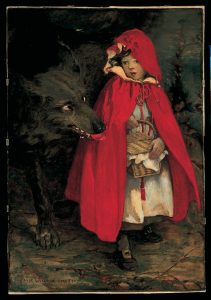The new museum features the vast art collection of Star Wars and Indiana Jones creator George Lucas. It is set to open in “a few short years” next to the Los Angeles Coliseum.
“These works illustrate that the desire to tell visual stories both fantastical and factual unites cultures around the world and across time and has taken all manner of forms,” says Ryan Linkof, the museum’s first curator. “We recognize that this type of comparison — flattening distinctions of culture and context — might ruffle the feathers of many art historians and curators.”
“While Lucas was creating some of the most iconic films of our time, he was also amassing an unparalleled collection of artwork spanning everything from ancient art to contemporary comics,” Linkof says.
The Lucas Museum of Narrative Art curatorial team offered a sneak peek at the collection during a panel presentation at San Diego Comic-Con 2019. The whirlwind tour featuring many works of art never publicly shown before represents only the “very tip of the iceberg.”
The goal of the Lucas Museum: breaking down the barriers between low and high art.
“We’re attempting to eliminate the hierarchy between so-called high art and commercial art, placing them on the same plane,” Linkof says. “Many museums pay lip service to this kind of inclusive appreciation of visual culture. However, we’re truly unique in making it central to the museum’s identity.”
Let’s take a closer look inside the still-under-construction art museum designed to transport visitors to another world filled with stories.
Star Wars & Indiana Jones
Firstly, the museum’s cinema holdings are one of the highlights of the collection. They feature items from Star Wars, Indiana Jones and also Industrial Light and Magic projects.
“The lion’s share of this material derives from the Lucasfilm production archive. It includes material from films created between the founding of the company in the mid-1970s to its acquisition by Disney in 2012,” Linkof says. “The archive is incredibly vast and includes material illustrating the entire filmmaking process. This also includes early concept materials used to envision the Star Wars universe.”
The Star Wars collection includes prop lightsabers, cinematic costumes and movie vehicles.
An early movie storyboard visualizes the opening sequence crawl with “The Star Wars” used as a working title. Master paintings produced by artist Ralph McQuarrie also show the early development and visualization of the original Star Wars trilogy. Several matte illustrations of Star Wars background scenes painted on glass shower doors are part of the collection.
Sketches, models and early concept art
“For me, these are really a highlight of the collection,” Linkof says. “They’re beautiful and painterly in person and feature many of the most iconic sites in the films.”
The deep Star Wars holdings include sketches showing the development of key characters across the sweep of the space opera film saga. Sketches show the creative evolution of C-3PO, who started out resembling Maria the robot from 1927’s “Metropolis.”
Among the most stunning pieces in the collection are prototype models from the “Star Wars” films.
“This model of the Death Star is really one of the most spectacular items in the archive. And it really has to be seen in person,” Linkof says. “It’s actually a large 3-D object approximately six feet tall. It is created out of thin layers of brass that have been eroded with acid. It’s incredibly intricate and truly stunning. It has never been shown publicly.”
The Indiana Jones material also includes early concept art from comic artists. Among the key Indy props: The Arc of the Covenant.
Science Fiction
Science fiction and fantasy are another key thematic area of the Lucas Museum collection. Works include pulp novel covers from mysteries, thrillers and westerns along with illustrations depicting H.G. Wells’ “The War of the Worlds.”
Illustrated covers from magazines like Astounding Stories and Startling Stories are also among the highlights.
In addition to this, the collection includes science fiction and fantasy work by artist John Berkey. He designed much of the movie poster art for Star Wars.
Comic Art
Comic art from the early to mid 20th century represents a significant strength of the collection. Works range from comic books and comic strips as well as political cartoons and editorial cartoons.
Erin Curtis is a curator and historian with the Lucas Museum. She says, “In recent years, comic art has stepped from the fringes of pop culture. It has taken its place as one of the greatest American art forms.”
A key portion of the collection focuses on the period from the birth of the Golden Age of Comics to the creation of the Comics Code Authority in 1954. Highlights of the comic art collection include early covers for iconic titles. For example, the X-Men, Iron Man, Thor, Tales from the Crypt and Heavy Metal.
Norman Rockwell
“Storytelling is a word frequently associated with the world of Norman Rockwell. His paintings entered the homes of millions of Americans on a bimonthly basis for nearly 75 years as cover illustrations for the Saturday Evening Post,” says Anastasia James, a curator with the Lucas Museum.
Rockwell’s paintings expressed complex narratives in a single image.
“The manner in which Rockwell executed his most ambitious paintings, with models and elaborate sets and costuming, is often compared to film direction,” James says. “Resulting in paintings where single image stories stand as moments in a larger overarching narrative in which proceeding and subsequent events are visually implied.”
Nursery Rhymes & Fairy Tales
Another notable focus of the Lucas collection is European and American children’s book illustrations from the 19th and 20th centuries. These pieces represent well-known nursery rhymes and fairy tales. For example, Little Red Riding Hood, Goldilocks and the Three Bears, Alice in Wonderland and Peter Rabbit.
Iconic Images
In addition to this, the museum collection will feature the largest single artwork in the world: The 3,000-foot-long “Great Wall of Los Angeles”. The massive image tells the history of the city from the perspective of women and people of colour.
The Lucas Museum will also be home to some of the most iconic images in the American visual vocabulary. These are Emanuel Leutze’s “Washington Crossing the Delaware” and Dorothea Lange‘s “Migrant Mother.” “What makes this collection unique is the eclecticism and variety,” Linkof says. “It is truly unlike any other museum collection.”
Kadir Nelson’s 2017 “Black Gothic” clearly references and updates “American Gothic”. The Ebony magazine cover serves as a contemporary counterpoint to other illustrations in the museum collection that appeared in magazines like Life and the Saturday Evening Post.
“We have a number of African American artists in the collection,” Curtis says. “Many of their works expand upon or challenge traditional representations of American history and culture.”
Ancient artworks
The museum also holds pieces that date back to ancient times. The earliest works in the collection date from ancient Egyptian, Greek and Roman periods.“These works express the basic grammar of visual storytelling which would take innumerable forms in the centuries to come,” Linkof said.

Medieval history paintings depict vivid action in near-photographic detail. “This was visual storytelling on the grandest of scales,” Linkof says. “There’s also something kind of cinematic about the scale and scope of these works.”
The Lucas Museum will also include permanent and temporary exhibition spaces. In addition, it will be home to two state-of-the-art theatres, a library, a restaurant, a cafe and a retail shop.


























